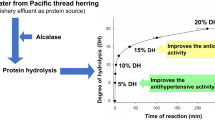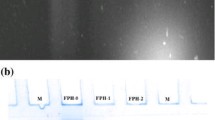Abstract
Enzymatic conversion of fish frame waste of threadfin breams (Nemipterus japonicus) to protein hydrolysate could be a solution for minimizing the pollution issues related to seafood processing operations and a way for the value addition to processing by-products. Protein hydrolysates from fish frame waste (FW) of thread fin breams (N. japonicus) were prepared and evaluated for bioactive properties such as angiotensin-I-converting enzyme (ACE) inhibitory activity and antioxidant and functional properties as a function of degree of hydrolysis (DH). Two different plant proteases, papain and bromelain, were used to prepare fish protein hydrolysates (FPH) and designated as HP (hydrolysates prepared using papain) and HB (hydrolysates prepared using bromelain). The ACE inhibitory activity of HP samples was higher at 5 and 10 % DH than that of the HB samples at DH 15 %, and there was no significant difference (p < 0.05). Antioxidant properties (2, 2 diphenyl-1-picrylhydrazyl [DPPH] radical scavenging activity, ferric reducing power and lipid peroxidation inhibition) of hydrolysates increased with increase in DH. The HB samples at DH 15 % had significantly higher antioxidant properties than HP samples (p < 0.05). The solubility of HP and HB samples was high in a wide range of pH and increased with DH. The functional properties of HP and HB samples decreased significantly with increase in DH (p < 0.05). The fractionation of the HB–DH 15 % sample yielded three peptide fractions with the approximate molecular weight of peptides in the range of 7562–812 Da. Relatively, bromelain enzyme is more effective in producing the FPH with desirable bioactive and functional properties.







Similar content being viewed by others
References
Adler-Nissen J (1986) Enzymatic hydrolysis of food proteins. Elsevier Applied Science, London
Aissaoui N, Abidi F, Hardouin J, Abdelkafi Z, Marrakchi N, Jouenne T, Marzouki MN (2016) ACE inhibitory and antioxidant activities of novel peptides from Scorpaena notata by-product protein hydrolysate. Int J Pep Res Ther doi. doi:10.1007/s10989-016-9536-6
Association of Official Analytical Chemists (AOAC) (2005) In: Horwitz (ed) Official methods of analysis 18th edn. AOAC international, Gaithersburg, Mary land, USA
Bougatef A, Arroume NN, Manni L, Ravellac R, Barkia A, Guillochon D, Nasri M (2010) Purification and identification of novel antioxidant peptides from enzymatic hydrolysates of (Sardinella aurita) by-products proteins. Food Chem 116:559–565
Chalamaiah M, Dinesh Kumar B, Hemalatha R, Jyothirmayi T (2012) Fish protein hydrolysates: proximate composition, amino acid composition, antioxidant activities and applications: a review. Food Chem 135(4):3020–3038
Chi CF, Cao ZH, Wang B, Hu FY, Li ZR, Zhang B (2014) Antioxidant and functional properties of collagen hydrolysates from spanish mackerel skin as influenced by average molecular weight. Molecules 19:11211–11230
Choi JY, Hur S, Choi BD, Konno K, Park JW (2009) Enzymatic hydrolysis of recovered protein from frozen small croaker and functional properties of its hydrolysates. J Food Sci 74:C17–C24
Elavarasan K, Shamasundar BA (2014) Angiotensin I-converting enzyme inhibitory activity of protein hydrolysates prepared from three freshwater carps (Catla catla, Labeo rohita and Cirrhinus mrigala) using Flavorzyme. Int J Food Sci Technol 49:1344–1350
Elavarasan K, Naveen Kumar V, Shamasundar BA (2014) Antioxidant and functional properties of fish protein hydrolysates from fresh water carp (Catla catla) as influenced by the nature of enzyme. J Food Proces Preserv 38:1207–1214
Furuta T, Miyabe Y, Yasui H, Kinoshita Y, Kishimura H (2016) Angiotensin I converting enzyme inhibitory peptides derived from phycobiliproteins of Dulse Palmaria palmata. Mar Drugs 14:32 doi:10.3390/md14020032
Geirsdottir M, Sigurgisladottir S, Hamaguchi P, Thorkelsson G, Johannsson R, Kristinsson H (2011) Enzymatic hydrolysis of blue whiting (Micromesistius poutassou): functional and bioactive properties. J Food Sci 76:C14–C20
Halim NR, Yusof HM, Sarbon NM (2016) Functional and bioactive properties of fish protein hydolysates and peptides: a comprehensive review. Trends Food Sci Tech 51:24–33
He S, Franco C, Zhang W (2013) Functions, applications and production of protein hydrolysates from fish processing co-products (FPCP). Food Res Int 50:289–297
Je JY, Qian ZJ, Byun HG, Kim SK (2007) Purification and characterization of an antioxidant peptide obtained from tuna backbone protein by enzymatic hydrolysis. Process Biochem 42:840–846
Keppel G, Wickens TD (1973) Design and analysis: a researcher’s handbook. Prentice-Hall, Inc, Englewood Cliffs, USA
Klompong V, Benjakul S, Kantachote D, Shahidi F (2007) Antioxidative activity and functional properties of protein hydrolysate of yellow stripe trevally (Selaroides leptolepis) as influenced by the degree of hydrolysis and enzyme type. Food Chem 102:1317–1327
Kristinsson HG, Rasco BA (2000) Fish protein hydrolysates: production, biochemical and functional properties. Crit Rev Food Sci Nutr 40:43–81
Lanier TC, Lee CM (1992) Surimi technology. Marcel Dekker, New York
Li-Chan EC (2015) Bioactive peptides and protein hydrolysates: research trends and challenges for application as nutraceuticals and functional food ingredients. Curr Opin Food Sci 1:28–37
Liu Y, Li X, Chen Z, Yu J, Wang F, Wang J (2014) Characterization of structural and functional properties of fish protein hydrolysates from surimi processing by-products. Food Chem 151:459–465
Lowry OH, Rosebrough NJ, Farr AL, Randall RJ (1951) Protein measurement with folin phenol reagent. J Biol Chem 193:256–275
Mahmoud MI (1994) Physicochemical and functional properties of protein hydrolysates in nutritional products. Food Technol 48:89–95
Malaypally SP, Liceaga AM, Kim KH, Ferruzzi M, Martin FS, Goforth RR (2014) Influence of molecular weight on intracellular antioxidant activity of invasive silver carp (Hypophthalmichthys molitrix) protein hydrolysates. J Funct Food. doi:10.1016/j.jff.2014.06.011ML
Mendis E, Rajapakse N, Byun HG, Kim SK (2005) Investigation of jumbo squid (Dosidicus gigas) skin gelatin peptides for their in vitro antioxidant effects. Life Sci 77:2166–2178
Mitsuda H, Yasumoto K, Iwami K (1966) Antioxidative action of indole compounds during the autoxidation of linoleic acid. Eiyo Shokuryo 19:210–214
Mutilangi WAM, Panyam D, Kilara A (1996) Functional properties of hydrolysates from proteolysis of heat-denatured whey protein isolate. J Food Sci 61(270–274):303
Nalinanoon S, Benjakul S, Kishimura H, Shahidi F (2011) Functionalities and antioxidant properties of protein hydrolysates from the muscle of ornate threadfin bream treated with pepsin from skipjack tuna. Food Chem 124:1354–1362
Naqash SY, Nazeer RA (2010) Antioxidant activity of hydrolysates and peptide fractions of Nemipterus japonicus and Exocoetus volitans muscle. J Aquat Food Prod Technol 19:180–192
Nasri R, Younes I, Jridi M, Trigui M, Bougatef A, Nedjar-Arroume N, Dhulster P, Nasri M, Karra-Châabouni M (2013) ACE inhibitory and antioxidative activities of goby (Zosterissessor ophiocephalus) fish protein hydrolysates: effect on meat lipid oxidation. Food Res Int 54:552–561
Nopianti R, Huda N, Ismail N, Ariffin F, Easa AM (2013) Effect of polydextrose on physicochemical properties of threadfin bream (Nemipterus spp) surimi during frozen storage. J Food Sci Technol 50:739–746
Osawa T, Namiki M (1985) Natural antioxidants isolated from Eucalyptus globules. J Agr Food Chem 33:777–780
Oyaiza M (1986) Studies on products of browning reaction: antioxidative activity of products of browning reaction prepared from glucosamine. J Nutr 44:307–315
Pacheco-Aguilar R, Mazorra-Manzano MA, Ramirez-Suarez JC (2008) Functional properties of fish protein hydrolysates from Pacific whiting (Merluccius productus) muscle produced by a commercial protease. Food Chem 109:782–789
Pearce KN, Kinsella JE (1978) Emulsifying properties of proteins evaluation of a turbidimetric technique. J Agr Food Chem 26:716–723
Prior RL, Wu X, Schaich K (2005) Standardized methods for the determination of antioxidant capacity of phenolics in foods and dietary supplements. J Agr Food Chem 53:4290–4302
Quaglia GB, Orban E (1990) Influence of enzymatic hydrolysis on structure and emulsifying properties of sardine (Sardina pilchardus) protein hydrolysates. J Food Sci 55:1571–1573
Raghavan S, Kristinsson HG (2009) ACE inhibitory activity of tilapia protein hydrolysate. Food Chem 117:582–588
Ramakrishnan VV, Ghaly AE, Brooks MS, Budge SM (2013) Extraction of proteins from mackerel fish processing waste using alcalase enzyme. J Bioprocess Biotech. doi:10.4172/2155-9821.1000130
Saiga A, Tanabe S, Nishimura T (2003) Antioxidant activity of peptides obtained from porcine myofibrillar proteins by protease treatment. J Agr Food Chem 51:3661–3667
Sarmadi BH, Ismail A (2010) Antioxidative peptides from food proteins: a review. Peptides 31:1949–1956
Sathe SK, Salunkhe DK (1981) Functional properties of the great northern bean (Phaseolus vulgaris L.) proteins: emulsion, foaming, viscosity and gelation properties. J Food Sci 46:71–74
Sathivel S, Bechtel PJ (2006) Properties of soluble protein powders from Alaska Pollock (Theragra chalcogramma). Int J Food Sci Technol 41:520–529
Sheriff SA, Sundaram B, Ramamoorthy B, Ponnusamy P (2014) Synthesis and in vitro antioxidant functions of protein hydrolysate from backbones of Rastrelliger kanagurta by proteolytic enzymes. Saudi J Biol Sci 21:19–26
Tanuja S, Aiswarya H, Zynudheen AA, Joshy CG (2014) Functional and antioxidative properties of fish protein hydrolysate (FPH) produced from the frame meat of striped catfish Pangasianodon hypophthalmus (Sauvage, 1878) using alkaline protease alcalase. Indian J Fish 61:82–89
Taylor WH (1957) Formol titration: an evaluation of its various modifications. Analyst 82:488–498
Thiansilakul Y, Benjakul S, Shahidi F (2007) Antioxidative activity of protein hydrolysate from round scad muscle using alcalase and flavourzyme. J Food Biochem 31:266–287
Wang JL, He GQ, Chen QH, Feng FQ, Yu GJ, Shoemaker CF (2011) Optimization of angiotensin I-converting enzyme inhibitory peptide production by ribbonfish (Trichiurus haumela) backbone hydrolysis using response surface methodology. J Food Process Preserv 34:2177–2190
Wang B, Wang YM, Chi CF, Luo HY, Deng SG, Ma JY (2013) Isolation and characterization of collagen and antioxidant collagen peptides from scales of croceine croaker (Pseudosciaena crocea). Mar Drug 11:4641–4661
Wijesekara I, Kim S (2010) Angiotensin-I-converting enzyme (ACE) inhibitors from marine resources: prospects in the pharmaceutical industry. Mar Drugs 8:1080–1093
Wu CH, Chen HM, Shiau CY (2003) Free amino acids and peptides as related to antioxidant properties in protein hydrolysates of mackerel (Scomber austriasi). Food Res Int 36:949–957
Wu S, Feng X, Lan X, Xu Y, Liao D (2015) Purification and identification of angiotensin-I converting enzyme (ACE) inhibitory peptide from lizard fish (Saurida elongata) hydrolysate. J Funct Food 13:295–299
Yen G, Wu J (1999) Antioxidant and radical scavenging properties of extract from Ganoderma tsugae. Food Chem 65:375–379
Zou TB, He TP, Li HB, Tang HW, Xia EQ (2016) The structure-activity relationship of the antioxidant peptides from natural proteins. Molecules 21:72. doi:10.3390/molecules21010072
Acknowledgments
INSPIRE fellowship by the Department of Science and Technology, Government of India, to the first author and funding provided by European Union, Brussels, under FP-7 (Grant No. 289282) for research work are gratefully acknowledged.
Author information
Authors and Affiliations
Corresponding author
Additional information
Responsible editor: Philippe Garrigues
Rights and permissions
About this article
Cite this article
Gajanan, P.G., Elavarasan, K. & Shamasundar, B.A. Bioactive and functional properties of protein hydrolysates from fish frame processing waste using plant proteases. Environ Sci Pollut Res 23, 24901–24911 (2016). https://doi.org/10.1007/s11356-016-7618-9
Received:
Accepted:
Published:
Issue Date:
DOI: https://doi.org/10.1007/s11356-016-7618-9




